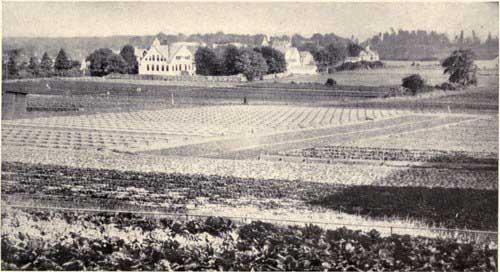A LIVING FROM THE LAND
(Frontispiece)
Country homes backed by intensive types of agriculture serve modern human needs.
A LIVING
FROM THE LAND
BY
WILLIAM B. DURYEE, M.Sc.
Secretary of Agriculture,
State of New Jersey
WHITTLESEY HOUSE
McGRAW-HILL BOOK COMPANY, INC.
NEW YORK AND LONDON
1934
Copyright, 1934, by the Mcgraw-Hill Book Company, Inc.
All rights reserved. This book, or parts thereof, may not be
reproduced in any form without permission of the publishers.
THIRD PRINTING
PUBLISHED BY WHITTLESEY HOUSE
A division of the McGraw-Hill Book Company, Inc.
Printed in the United States of America by The Maple Press Co., York, Pa.
To my friend
Henry W. Jeffers
PREFACE
Homesteading days are here again. The present movement of people back tothe land is of a different type and has different objectives from thosewhich prevailed when a continent was to be conquered and exploited. Todaywe know that many urban industries will operate on a seasonal basis and weknow too that periods of unemployment and shorter working days willprovide more leisure and probably lower incomes for hundreds of thousandsof families. The utilization of this leisure time to supplement incomes,to raise the standards of living and of health, and to attain some measureof economic security will tend more and more to settlement on the land.
In these days of rapid transportation and all the attributes andconveniences of modern country life, the hardships of the earlier periodof land development are non-existent. Although urban industrialdevelopment has reached a point which will not be exceeded for many yearsto come, the individual who needs additional income may adjust himself tosuch circumstances by establishing a country homestead.[Pg x] Industrialactivity is tending to decentralize, largely as the result of widespreadpower distribution, and a home in the country accessible to some form ofmanufacturing or business employment offers undeniable attractions.
This book is prepared primarily for the family that is inexperienced incountry living and in soil culture. Such a family should know about thenature of the soil on which it lives, how to make it serve the family’sneeds and purposes, what to do, and what to avoid in order that successmay be attained and failure averted. Students of agriculture as a vocationand practical farmers may find, beyond the elementary facts presented,information of value and help to them. To know and to understand thescience and practice of agriculture is to have power to cope with and toenjoy soil culture and animal husbandry. If this little volume helps toanswer clearly and definitely the many inquiries that are in the minds ofprospective and active homesteaders, it will have served its purpose.
The knowledge of many practical people and the resources of agriculturalinstitutions and
